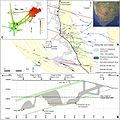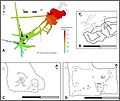Rising Star Cave
| Rising Star Cave
|
||
|---|---|---|
| Location: | Krugersdorp , South Africa | |
|
Geographic location: |
26 ° 1 '13 " S , 27 ° 42' 43" O | |
|
|
||
| Discovery: | 2013 | |
| Particularities: | Fossil site | |
The Rising Star Cave (English: Rising Star Cave ; literally: "Rising Star Cave") is a South African fossil site in the area of the UNESCO World Heritage Site Cradle of Humankind , not far from Krugersdorp . In September 2013, a passage was discovered in the cave system that "leads to a spectacular site of hominin bones".
location
The Rising Star cave system is located in the valley of the Bloubank River, 2.2 kilometers west of the Sterkfontein fossil site . The cave system was washed out in a 10 to 20 meter thick layer of dolomite and extends (as of 2015) over an area of 250 × 150 meters. The fossil-bearing section of the cave, known as the Dinaledikammer (German for "Sternenkammer"), is 30 meters below today's ground and is about 80 meters from the nearest cave entrance. Access to this chamber is difficult, especially because there is a bottleneck that is only 20 centimeters wide. The retrieval of the fossils was therefore preceded by a call on Facebook , Twitter and LinkedIn , in which “tiny and narrow” helpers were sought and found.
Fossil finds
Under the direction of Lee Berger , several hundred bones have been recovered from the Dinaledi chamber since 2013, both from the head and from the body below the head. They come from at least 15 individuals and their discoverers - despite the lack of dating - placed them in the phylogenetic relationship of the early ancestors of anatomically modern humans ( Homo sapiens ), although the finds could have been dated using calcium deposits.
In September 2015, Lee Berger and his team published a scientific description of the finds, in which they were assigned to the newly introduced species Homo naledi .
Based on anatomical features, an estimated age of 1.5 to 2 million years was initially given for these finds in 2014, but this was revoked in 2017: According to this, the fossils are 335,000 to 236,000 years old.
The more than 1500 bones found between 2013 and 2014 come from a one by one meter excavation with a cumulative height of 20 cm, this excavation area contained neither stone tools nor bones of animals.
In 2017, the discovery of further fossils was announced, which had been found around 100 meters away from the Dinaledi chamber in a second chamber - called the Lesedi chamber. These are the remains of three individuals, including the well-preserved LES1 skull of an adult.
See also
literature
- Catherine Brahic: Chamber of Secrets. In: New Scientist . Volume 224, No. 2997, November 29, 2014, pp. 40-43.
Web links
- In the cradle of humanity. On: fr-online.de of December 2, 2013, accessed on September 28, 2019.
- The Rising Star Expedition at: nationalgeographic.com , viewed on September 28, 2019 (with various images).
- First Look Inside the Fossil Cave (Expedition Update). Video from National Geographic on youtube.com .
gallery
The Dinaledi chamber, where Homo naledi was found
Individual evidence
- ↑ Kate Wong: Incarnation in a New Light. In: Spectrum of Science . No. 1/2015, p. 22
- ^ Paul HGM Dirks et al .: Geological and taphonomic context for the new hominin species Homo naledi from the Dinaledi Chamber, South Africa. In: eLife. 2015; 4: e09561, doi: 10.7554 / eLife.09561
- ^ New human species discovered. On: sciencemag.org of September 10, 2015, doi: 10.1126 / science.aad1728 . In the original: "tiny and small, specialized cavers and spelunkers with excellent archaeological, palaeontological and excavation skills."
- ↑ a b Lee R. Berger et al .: Homo naledi, a new species of the genus Homo from the Dinaledi Chamber, South Africa. In: eLife. 2015; 4: e09560, doi: 10.7554 / eLife.09560
- ^ Anthropology Prof. John Hawks and UW-Madison students dig up crucial remnants of early hominids. On: isthmus.com of September 17, 2014, accessed on December 22, 2014.
- ↑ Anthropologist, 'underground astronaut' strike fossil gold in South Africa dig. On: news.wisc.edu (University of Wisconsin Medison) on December 6, 2013, accessed on December 22, 2014
- ↑ Next stage of the “Rising Star” expedition. On: deutschlandfunk.de of April 2, 2014, accessed on December 22, 2014.
- ^ Paul HGM Dirks et al .: The age of Homo naledi and associated sediments in the Rising Star Cave, South Africa. In: eLife. 2017; 6: e24231, doi: 10.7554 / eLife.24231
- ^ News from the Field by Trenton Holliday, Professor and Chair of Anthropology at Tulane University, June 6, 2014, accessed December 22, 2014.
- ^ John Hawks et al .: New fossil remains of Homo naledi from the Lesedi Chamber, South Africa. In: eLife. 2017; 6: e24232, doi: 10.7554 / eLife.24232








